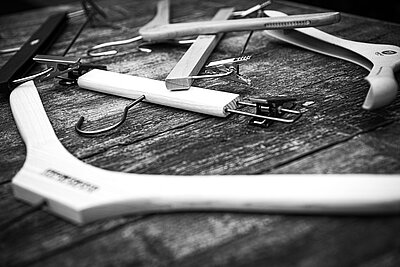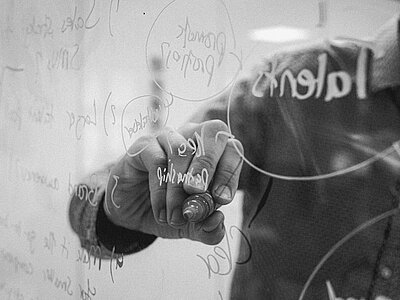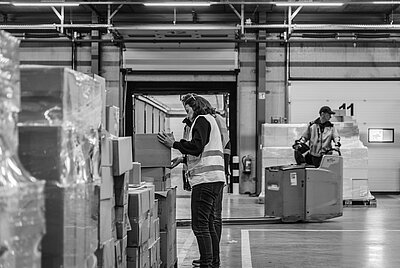Through customer feedback and our own research, we are expanding our in-store and e-commerce consumables all the time. We work closely with our customers to advise them on how to reduce their environmental impact too, whether that’s ordering boxes that are just the right size for their products to reduce the need for excess filling materials or using water-based ink for printing.
Our Service with Guts motto extends to every area of our business – and sustainability is no different. We want to do as much as we can for our customers, and the planet, to be as sustainable as we can be.
To help with this, we have rounded up our four examples of sustainable product lines to show you how small changes can make a big impact.
E-commerce boxes
Many of our e-com boxes are made of a mix of recycled and virgin paper and as part of our service with guts mission, we are always on hand to give advice to our customers to ensure that at the end of life, they are recyclable. Making products from recycled materials and recycling those products at the end of their life is important for us to be able to close the lifecycle.
One of the hardest parts of packaging sustainability is ensuring it makes it to the recycling facility once it has been used, and lots of factors can contribute to making cardboard ineligible for recycling. Leaving on tape, glitter, grease, embossing or non-paper materials attached to the cardboard can all prevent it from being used. To increase the chance of our boxes being recycled sustainably at the end of their lives, we only use water-based inks when we print on our boxes so that damage to the environment is minimised.
We always work alongside our customers to show them the most sustainable options for their packaging.
Plastic bags
Believe it or not, sometimes the most sustainable choice, depending on what you need your packaging for, is a plastic bag. We wrote about the misconceptions around plastic packaging recently in response to the worldwide cardboard shortages. It is easy to forget that the production process for cardboard is far more carbon-intensive than plastic production.
We have a range of bags that are made from 80-85% recycled plastic, which are then recyclable at the end of their lifecycle. They also take up less room to store than paper bags or cardboard boxes, so when it comes to storing and transporting there can often be significant carbon savings.
We make sure we get a full picture of what our customers need and their sustainability goals so that we can make sure they are choosing the best option and looking at the whole sustainability picture – not just part of it.
Re-useable bags
Since the introduction of restrictions on plastic bags in the EU, most people are now used to considering how they might re-use their plastic bags or looking to invest in a bag that is reusable.
In retail, integrating this change in thinking as part of your sales and marketing process can be an important sustainability win – and savvy brands recognise and act on this.
Recently, Anya Hindmarch, the British accessory designer who sent shoppers wild in the aisles of Sainsbury’s with the I Am Not a Plastic Bag that opened a debate on single-use plastic in 2007, has launched a new bag she hopes will revolutionise the way we carry our shopping.
Intended to modernise the idea of how a shopping bag is used and thought of, Hindmarch’s new bag is a luxury item with a supermarket price tag of £10. It is made of recycled plastic and is fully recyclable.
“We’re never going to get away from needing bags because we need to move things from one place to another,” she says. Instead, she hopes that the universal bag will encourage shoppers to think of long-term solutions.
Companies that recognise their supporting materials can be used to emphasise their brand are long term winners, as consumer behaviour and trends emerge, sometimes in the strangest of ways. The current trend in Shanghai , which is under a strict lockdown at the moment, is that wealthy residents are using designer branded bags for their Covid rapid antigen self-test kits, which are collected daily by health workers as part of efforts to minimise contact.
To show off their wealth and status, it seems that the shopping bags from luxury brands including Prada, Louis Vuitton and Hermes are being seen hanging outside apartment doors across the city – and are more coveted than the actual real product.
Paper mannequins
Something new that we are offering our customers is 100% recyclable, paper mannequins. They are produced using green energy and they are strong and durable, just like their plastic or fibreglass counterparts. But at the end of their life, our paper mannequins can be recycled easily.
For sustainability-conscious brands and stores this is a change that’s easy to make. They are made with high-quality fittings that are built to last just as long as their plastic or fibreglass equivalents.
There are some specialist services that will recycle plastic of fibreglass mannequins, or refurbish them and re-use them, but it can cost retailers money. With our paper-based mannequins, the paper elements can be recycled as easily as cardboard. Simply take them to the local recycling point.
It is important for us to be here for our customers to show them the small steps they can take to be more sustainable – and this is a great example of how we can help them do that.
You are one-step away from taking a more sustainable approach to your packaging and in-store consumables – call our account managers on +31(0) 88 494 20 80 or email online@worldpack.eu


